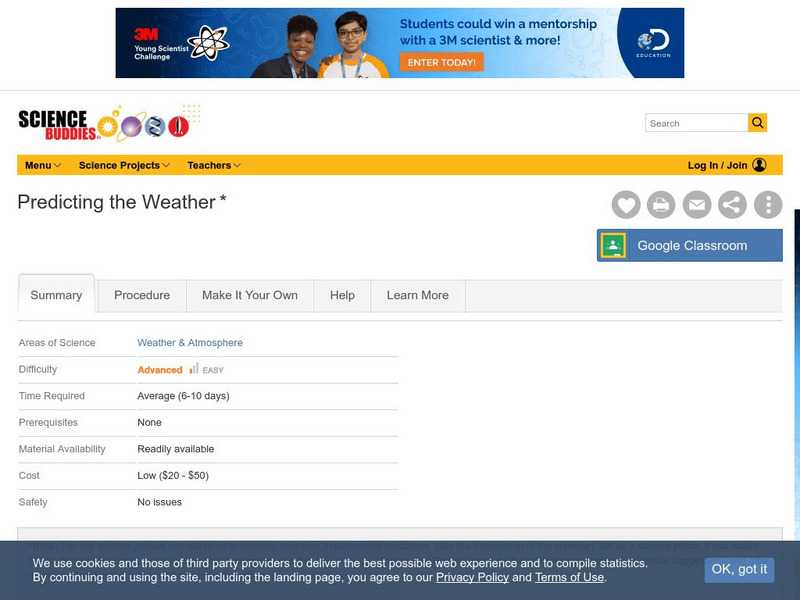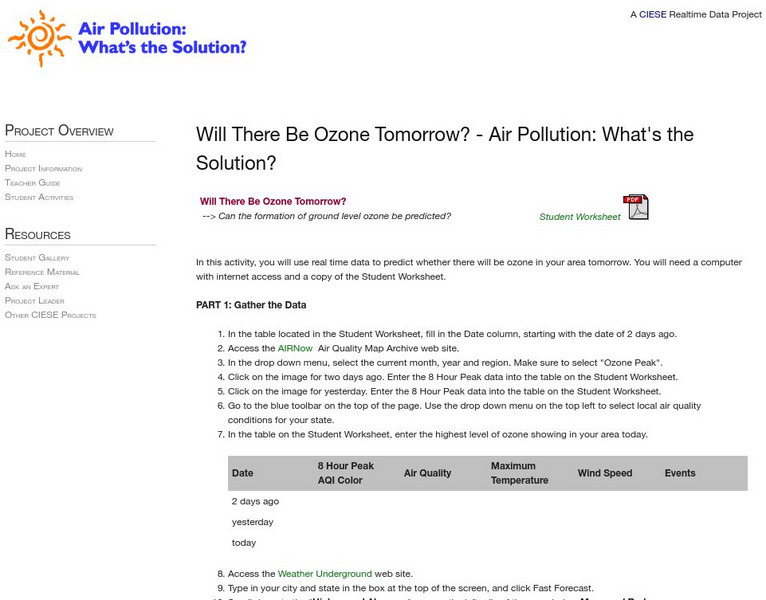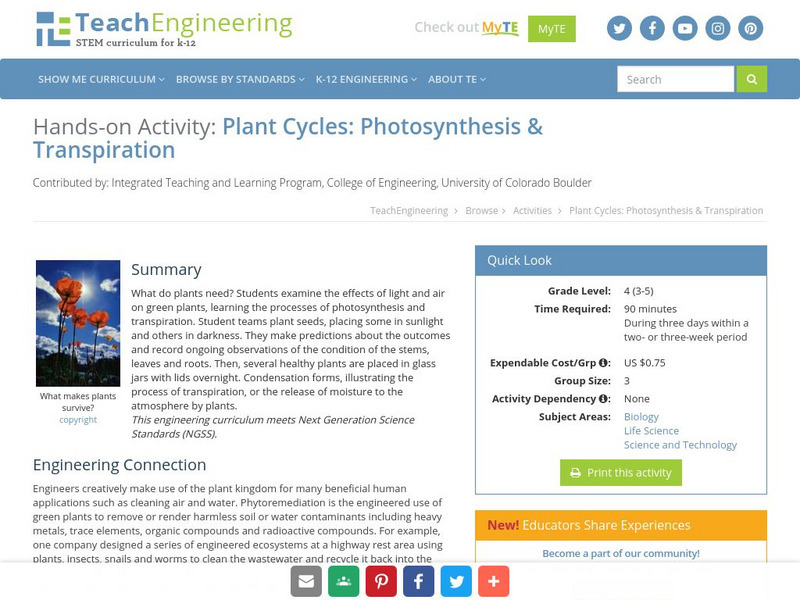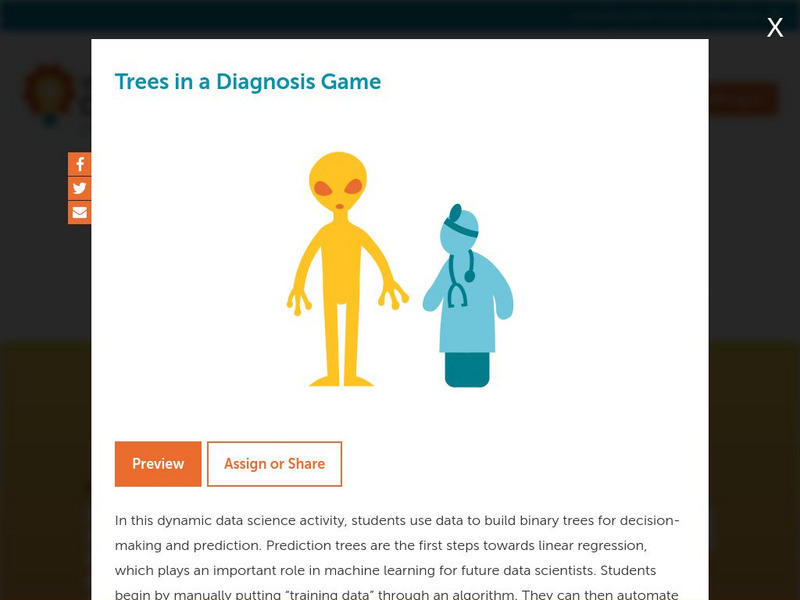PBS
Pbs Learning Media: Finding Patterns to Make Predictions
Make predictions then explore the patterns found in everyday objects like stairs. This interactive exercise focuses on developing an equation to represent a mathematical rule and working with virtual manipulatives to visualize a concept,...
Science Buddies
Science Buddies: Predicting the Weather
Here's a good way to get yourself on TV. This science fair project will help you learn how to predict the weather. So who knows, maybe you'll be more accurate than your local meteorologist.
Other
Kiddie Matters: Best Guide for Teaching Kids the Decision Making Process Steps
Kids have to make a wide range of decisions on a daily basis. It can get overwhelming if kids aren't armed with the right tools to make good decisions. When children learn the decision-making processing steps, they make more responsible...
University Corporation for Atmospheric Research
Ucar: Make a Weather Forecast
Review these tips and learn to make predictions of the weather.
Alabama Learning Exchange
Alex: Lip Balm Science
During this lesson, students will make three types of lip balm. They will then predict which lip balm they think will be preferred by testers and test that prediction by collecting data from testers who sample the lip balms. They will...
Alabama Learning Exchange
Alex: Teaching Measurement: Literature and Manipulatives
The tradebook, Who Sank the Boat? by Pamela Allen, is an excellent tool in teaching measurement. Students will engage in activities involving different types of measurement. In the story, five animal friends decide to take a boat ride....
Alabama Learning Exchange
Alex: Literary Elements in Jan Brett's the Mitten
Learners will analyze such literary elements as plot, cause-effect relationships, sequence, and prediction in Jan Brett's The Mitten. Students will enjoy predicting upcoming story events and retelling the story from a dialogue that shows...
Alabama Learning Exchange
Alex: What in the World Is Wrong With Sammy?
This lesson provides students with the technology-based project researching Guinea Pigs. The trade book, Sammy, the Classroom Guinea Pig, will be used to make predictions.The students will use the facts from their research to create a...
Center for Innovation in Engineering and Science Education, Stevens Institute of Technology
Ciese Real Time Data Projects: Air Pollution: Will There Be Ozone Tomorrow?
Collect and analyze real time ozone data to make determinations about the status of ozone in your local area. See if you can apply what you learn to make predictions about tomorrow's ozone levels.
TeachEngineering
Teach Engineering: Plant Cycles: Photosynthesis & Transpiration
What do plants need? Students examine the effects of light and air on green plants, learning the processes of photosynthesis and transpiration. Student teams plant seeds, placing some in sunlight and others in darkness. They make...
Concord Consortium
Concord Consortium: Trees in a Diagnosis Game
In this dynamic data science activity, students use data to build binary trees for decision-making and prediction. Prediction trees are the first steps towards linear regression, which plays an important role in machine learning for...
TeachEngineering
Teach Engineering: The Beat Goes On
In this activity, students learn about their heart rate and different ways it can be measured. Students construct a simple measurement device using clay and a toothpick, and then use this device to measure their heart rate under...
TeachEngineering
Teach Engineering: Kinetic and Potential Energy of Motion
In this lesson, students are introduced to both potential energy and kinetic energy as forms of mechanical energy. A hands-on activity demonstrates how potential energy can change into kinetic energy by swinging a pendulum, illustrating...
TeachEngineering
Teach Engineering: Do Different Colors Absorb Heat Better?
Students test whether the color of a material affects how much heat it absorbs. Students will place an ice cube in a box made of colored paper (one box per color; white, yellow, red and black), which they will place in the sun. The...
Wisconsin Response to Intervention Center
Wisconsin Rt I Center: Pals [Pdf]
Classroom teachers will learn about Peer Assisted Learning/Literacy Strategies (PALS) an engaging instructional strategy for students. Teachers will learn how to implement PALS, understand how to measure progress with PALS, and find...
PBS
Pbs: Scientific American Frontiers: The Arctic Our Global Thermostat
Scientists believe that the climate in the Arctic is an indicator of global climatic conditions. Learn what makes the Arctic so unique and how scientists use this information to predict global changes. Informative photos accompanied by...
Concord Consortium
Concord Consortium: Bar Ty
Modeling traffic data is important for urban planning, creating transportation systems, and even predicting how much foot traffic a retail store can expect in a given day. This genre of dynamic data science activities could be classified...
Read Works
Read Works: Fourth Grade: Three Lesson Unit: Figurative Language
[Free Registration/Login Required] A lesson plan, based on In a Pickle and Other Funny Idioms by Marvin Terba, in which students learn how understand idioms and use them to explain the plot and to make predictions. With free login, users...
Science Buddies
Science Buddies: The 'Ultimate' Science Fair Project: Flying Disk Aerodynamics
Tossing a Frisbee with your friends is a great way to have fun in the sun. As you practice your throws and become more accurate, you're learning about the aerodynamics of Frisbee flight intuitively. You're learning the body mechanics...
















